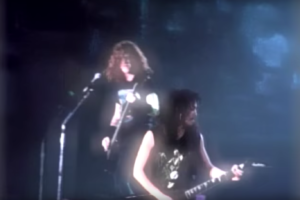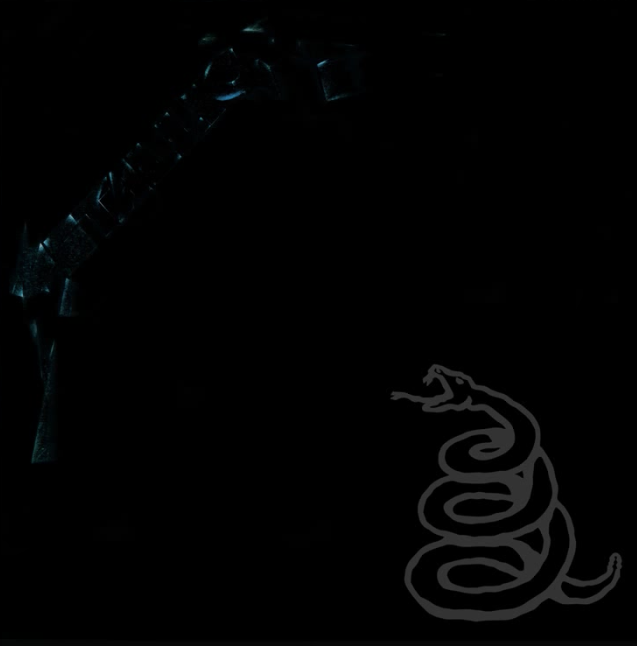27 years ago, heavy metal juggernaut Metallica released the follow-up to 1988’s “…And Justice For All,” the self-titled “Black Album” on August 12, 1991.
At a time where Metallica was on top of the world, they decided to experiment with their sound and venture outside the thrash metal genre. Several standout tracks such as “Enter Sandman,” “Sad But True” and “Wherever I May Roam” were conceived and written during the Damaged Justice Tour.
The band had become bored with the 10-minute epic songs that had become common on previous records. Guitarist Kirk Hammett noticed that fans seemed bored at live shows during these rock odysseys.
Drummer Lars Ulrich said “we had pretty much done the longer song format to death… We felt inadequate as musicians and as songwriters, that made us go too far in… the direction of trying to prove ourselves.”
They wanted to create their best record yet and sought out Bob Rock to produce it. Rock was known for producing several Motley Crue albums, most notably “Dr. Feelgood,” and releases of Aerosmith, Bon Jovi, The Cult and David Lee Roth.
“With Bob, we wanted a good mix,” Ulrich said in “Metal: The Definitive Guide.” “We wanted that big sound at the bottom end, and I don’t care if that song is on a Bon Jovi record, a Cult record or a Metallica record. The sound is the sound and we needed that.”
However, Rock’s perfectionist nature clashed with the band. He upset the status quo the band was used to in the studio by having them change the key of songs, making them record in a room together instead of individually and challenged frontman James Hetfield to write better lyrics.
 One such example is the lyrics for the lead single “Enter Sandman.” The original lyrics very explicitly talked about an infant dying in its crib; very dark, even for Metallica. Rock coaxed Hetfield into rewriting the lyrics and it turned into the metal anthem we know today about nightmares.
One such example is the lyrics for the lead single “Enter Sandman.” The original lyrics very explicitly talked about an infant dying in its crib; very dark, even for Metallica. Rock coaxed Hetfield into rewriting the lyrics and it turned into the metal anthem we know today about nightmares.
The themes of the album were more introspective than their previous releases for several reasons, one of which was the fact that Hammett, Ulrich and bassist Jason Newsted were all going through a divorce. All three cite this as factors that inspired them to put all their effort into the album.
The introspective lyrics were seen in songs like “The God That Failed,” which dealt with Hetfield’s mother’s death due to cancer and her Christian science beliefs that kept her from seeking treatment. “Nothing Else Matters” is a love song he wrote about missing his girlfriend while on the road.
Another change Rock made to the group was having the band play to the rhythm of Ulrich’s drumming, instead of Hetfield’s guitar. This was in an effort to make the album have more of a groove to it.
They spent eight-months recording the album, and after that the band and Rock remained unsatisfied. Following this was three complete remixes that cost $1 million.
Finally seeing their vision realized, the album released to critical and commercial success. It was the first Metallica album to debut at number one on the Billboard 200. It sold 598,000 copies in its first week. At the end of its run, it sold 16 million copies in the U.S. In total, “Metallica” sold 31 million copies worldwide.
The album was lauded by several publications including Rolling Stone, The New York Times and Entertainment Weekly, among others. They praised the evolution of the band’s sound, the catchy songs and the more mature lyrics from Hetfield.
 It is seen as one of the better albums of Metallica’s discography and following it were lackluster albums such as “Load” and “St. Anger.” It’s also heralded as the moment when the band began “selling out,” by crafting shorter, more conventional songs and letting thier sound become somewhat mainstream.
It is seen as one of the better albums of Metallica’s discography and following it were lackluster albums such as “Load” and “St. Anger.” It’s also heralded as the moment when the band began “selling out,” by crafting shorter, more conventional songs and letting thier sound become somewhat mainstream.
I’m sort of in the minority in that I personally love this album and it is probably my 3rd favorite Metallica album, second only to “Master of Puppets” and “Ride the Lightning.” This was also the first Metallica album I ever heard.
Back when I was 11 or 12 I started going through a big box of CDs owned by my dad. He had everything from Billy Joel’s “The Stranger,” “The Traveling Wilburys,” “Pure Funk” and Nirvana’s “Nevermind.”
Then I picked up an album with a completely black cover and a faded out grey outlined snake. I couldn’t even find the Metallica logo on the cover. Regardless I popped it in and “Enter Sandman” blew my mind.
I listened to the whole album and loved it. I needed more. So I talked to my metalhead mom, who grew up in the 80s and she gave me “Master of Puppets.” From then on, Metallica held a soft spot in my heart and it opened the gateway for me to listen to more heavy metal.
So I do feel some nostalgia whenever I hear this album, but in my opinion it is a very good release on its own. While “Metallica” had shorter run times, booming choruses and a more conventional sound, it still had something unique and a solid groove.
Plus, compare the dynamic, meaningful sound and lyrics of this album to the sequel “Load,” and its night and day.
This album continues the tradition of all black covers translating to massive success and a turning point in a band’s direction (i.e. “Back in Black”). This is Metallica at their most mature and while it doesn’t hit the highs of their 80s releases, it’s just a notch below it, especially considering following this would be over a decade and a half of mediocrity.
 Henry Wolski
Henry Wolski
Executive Editor


